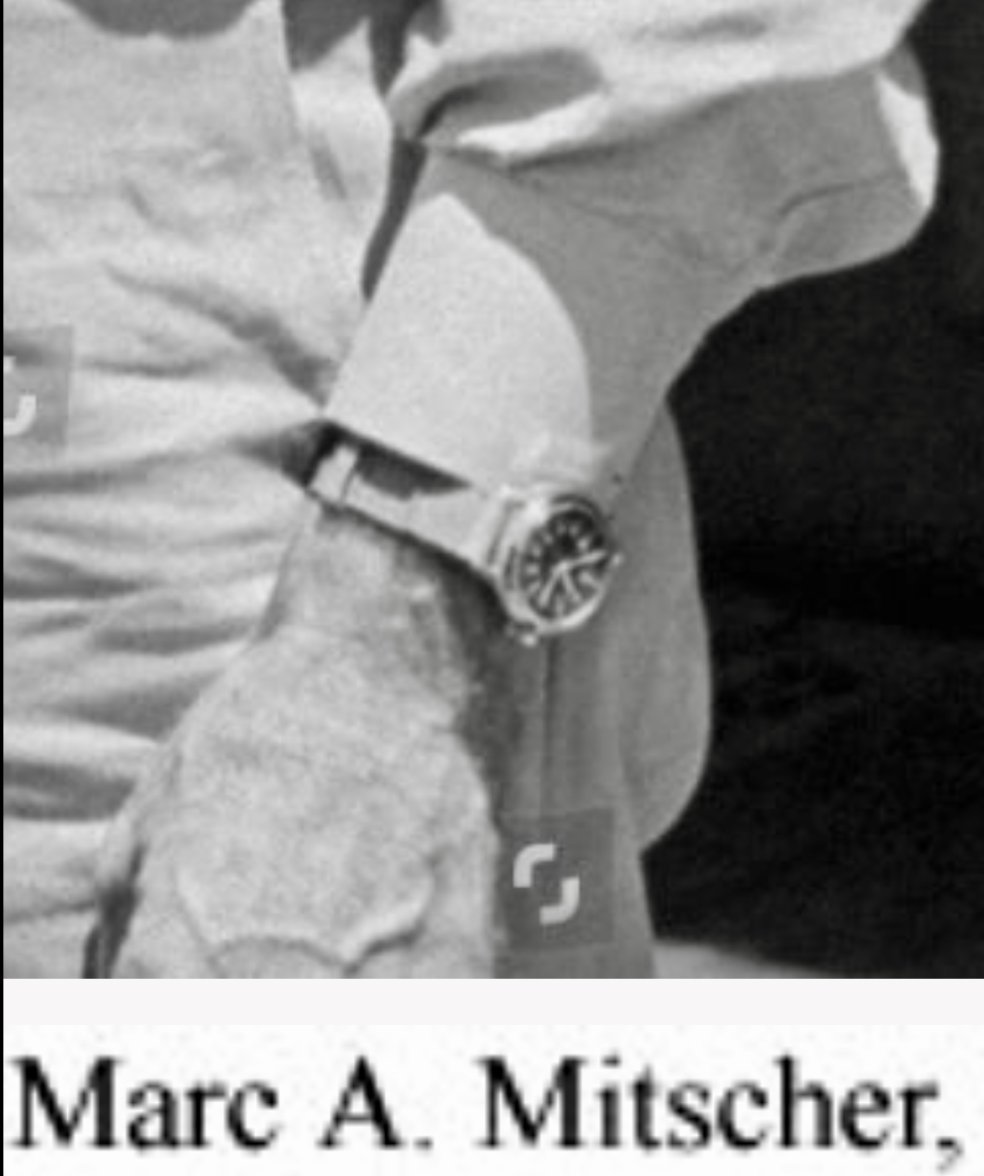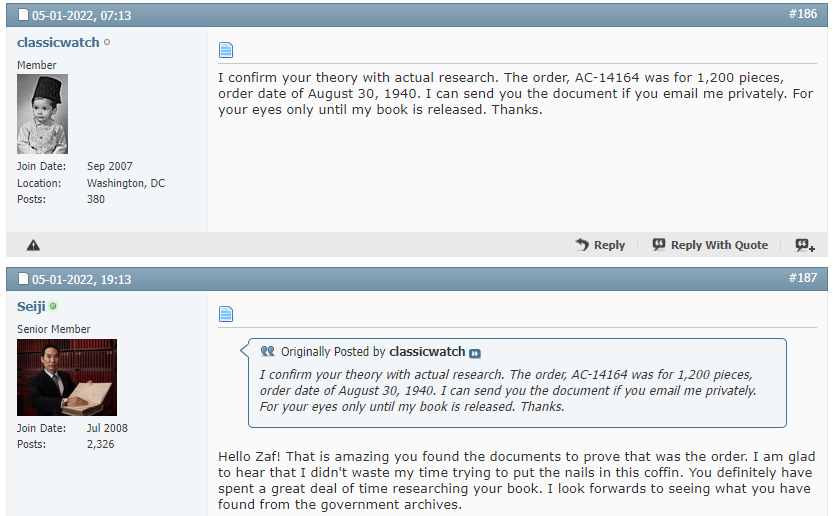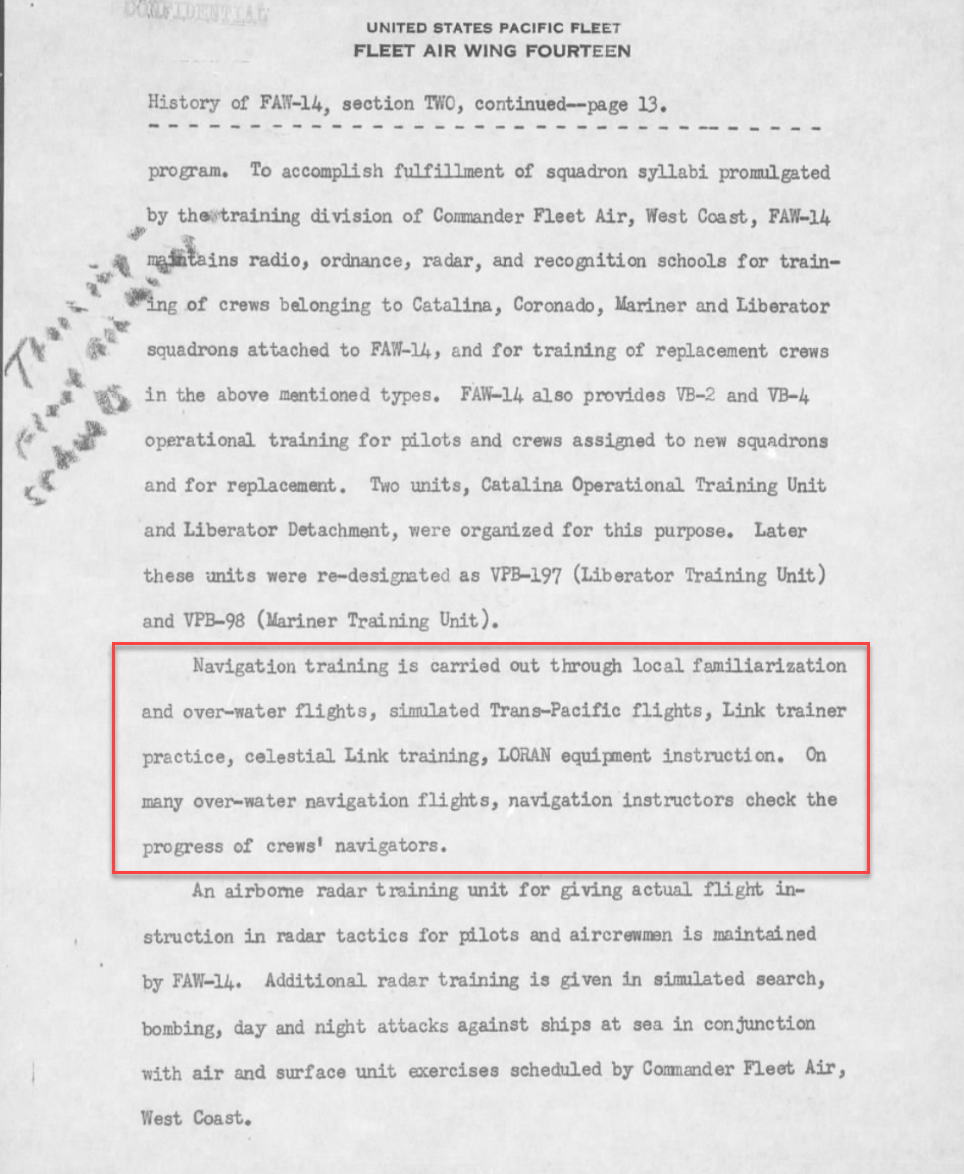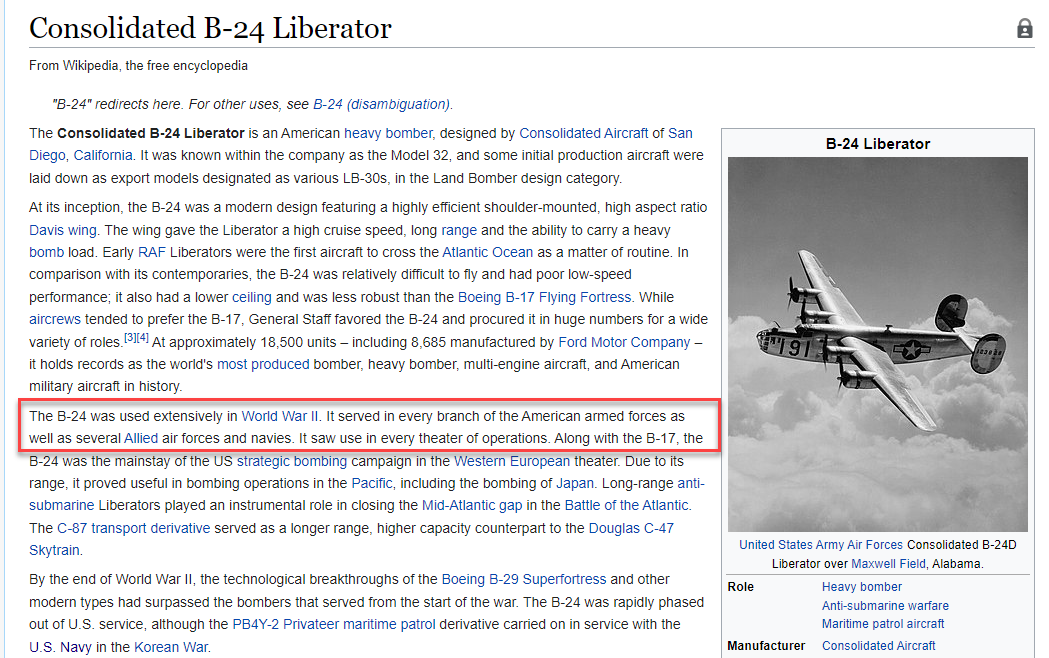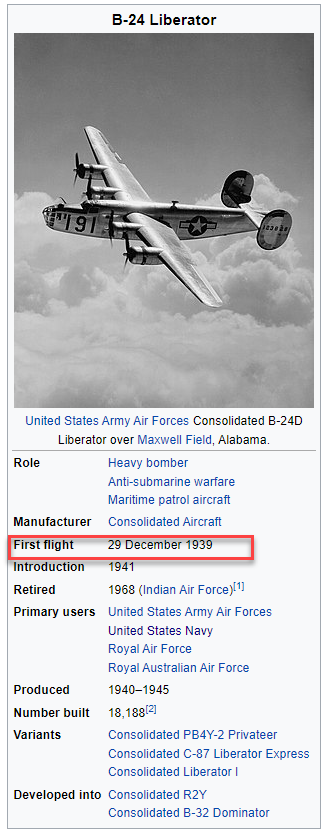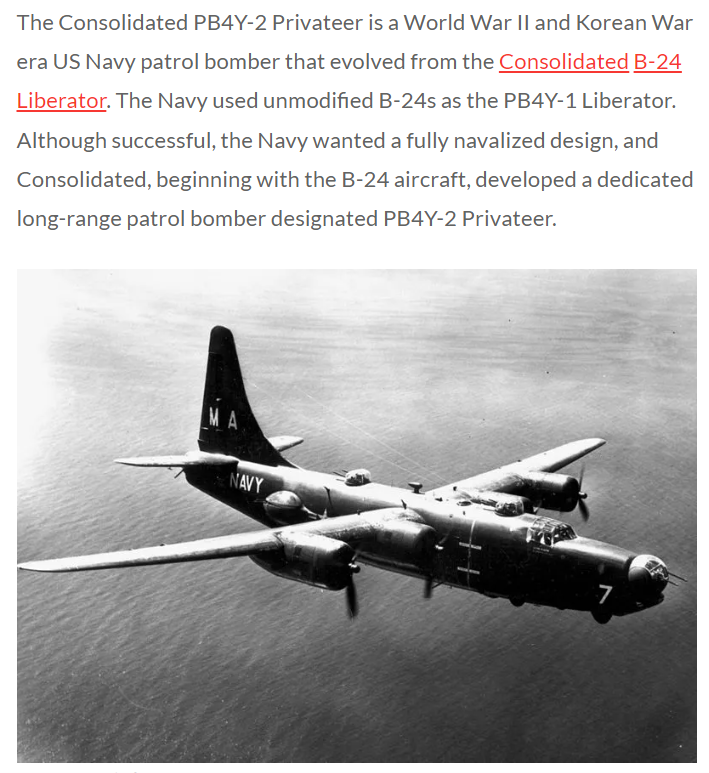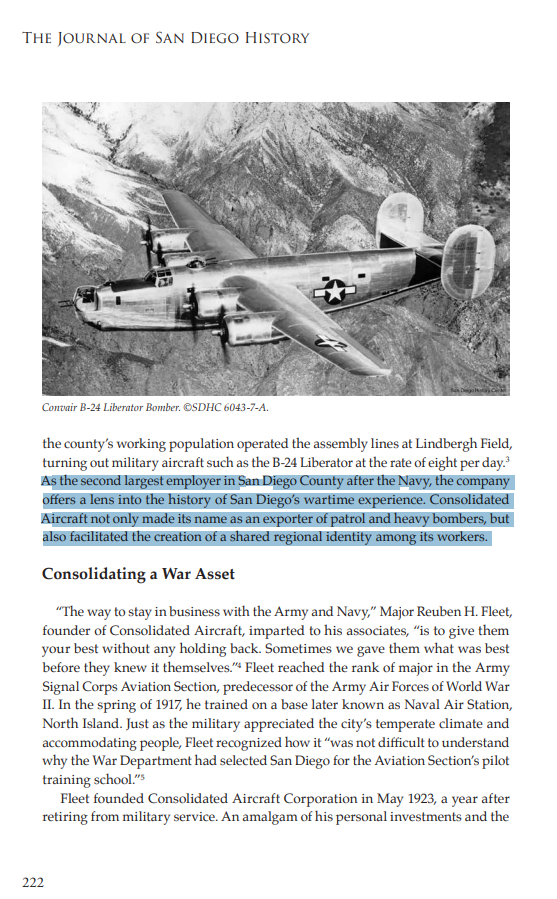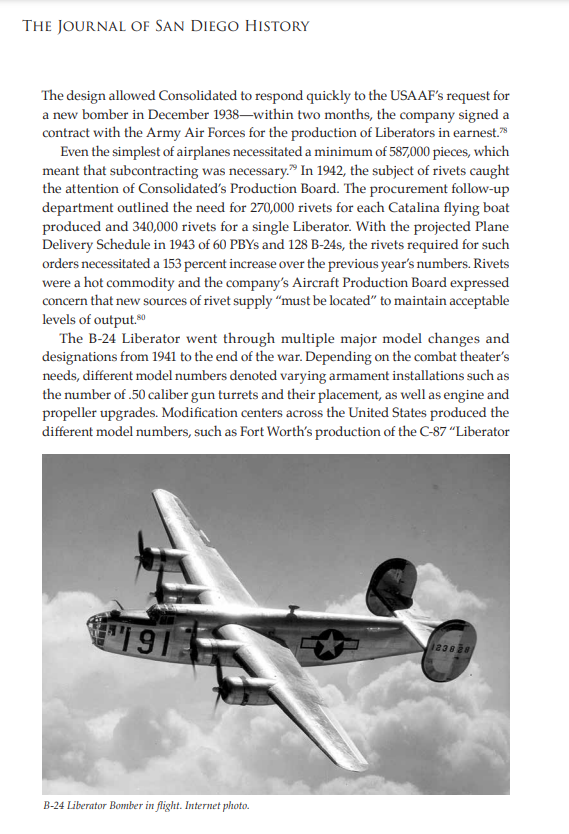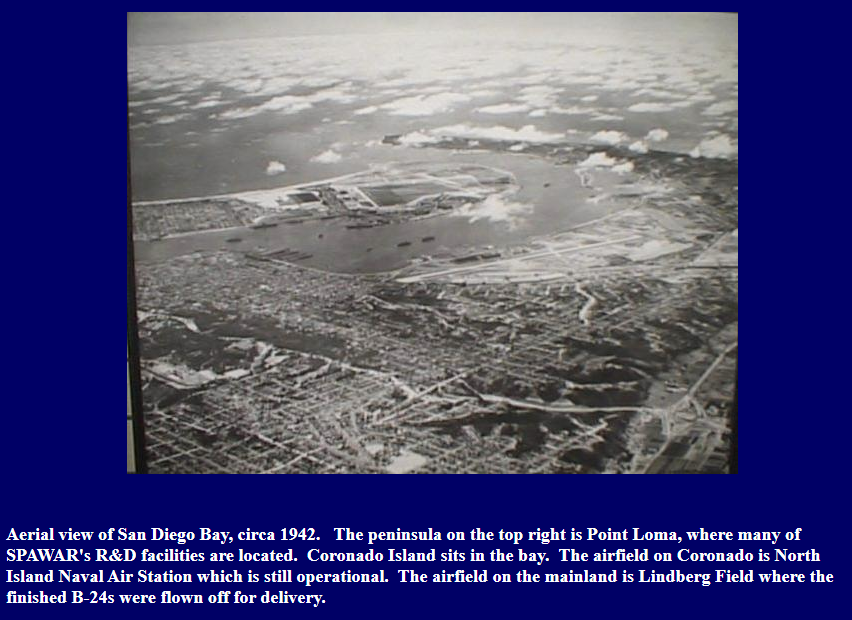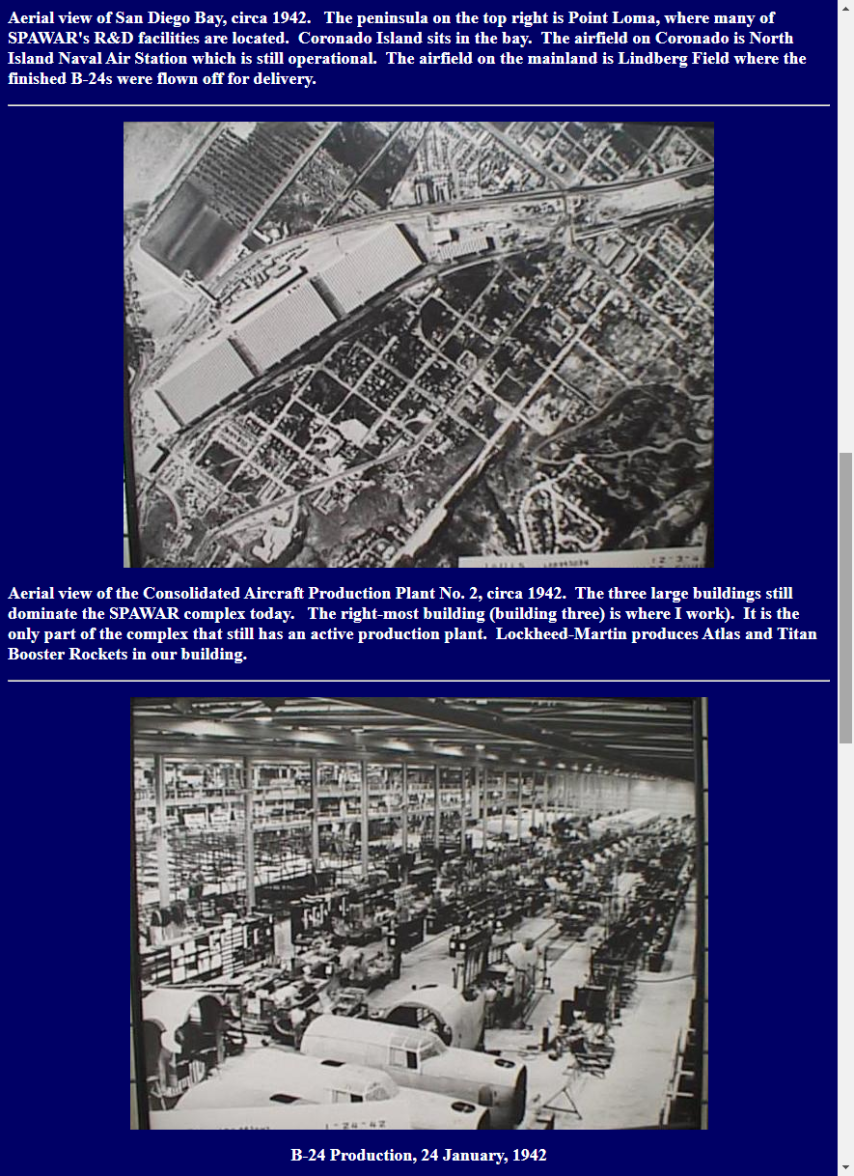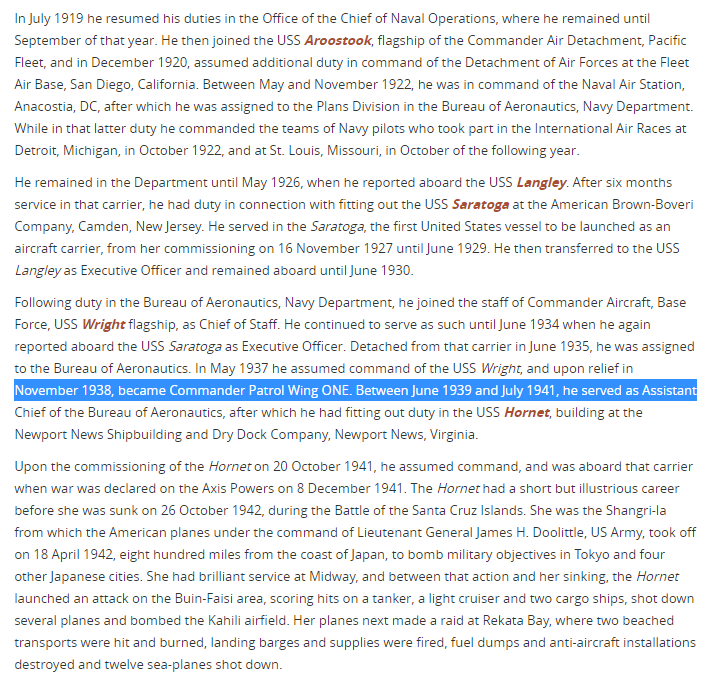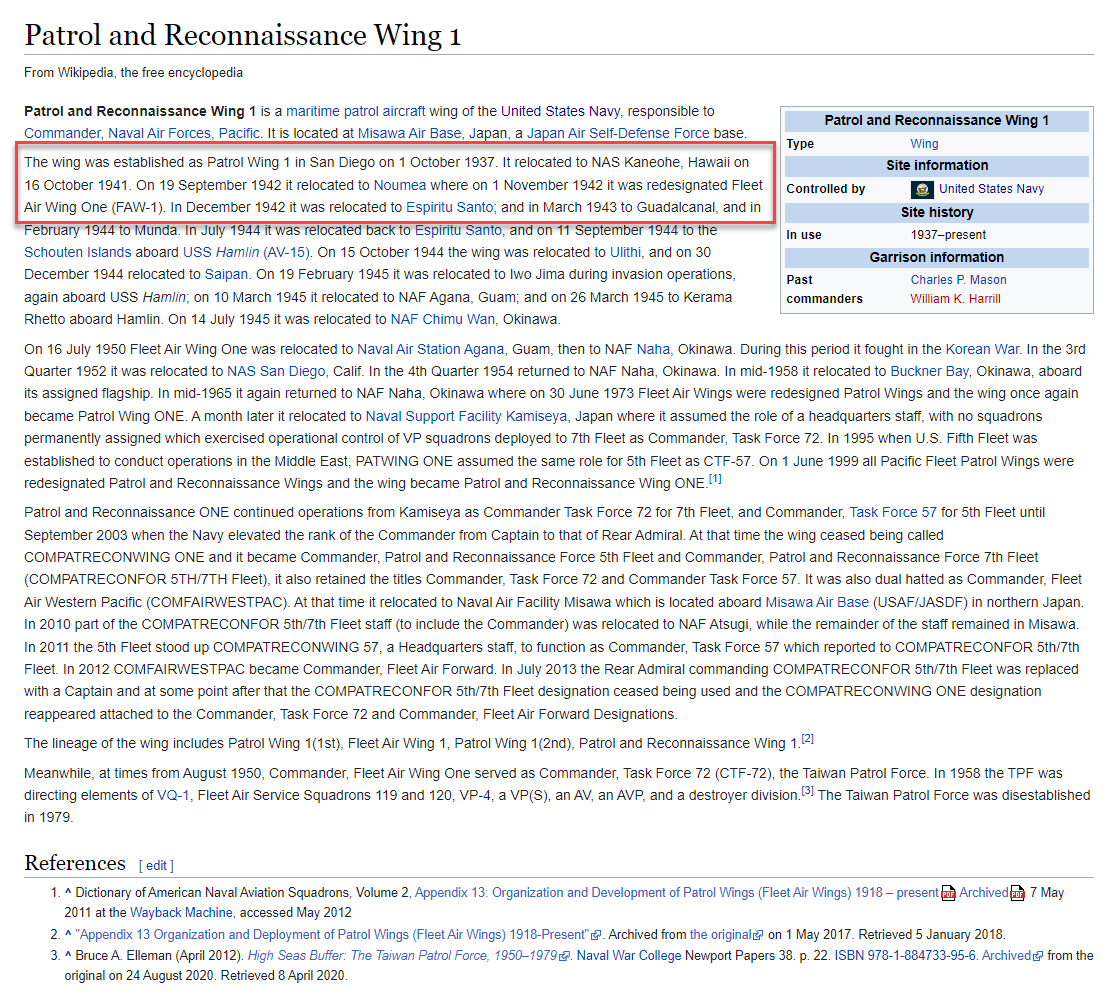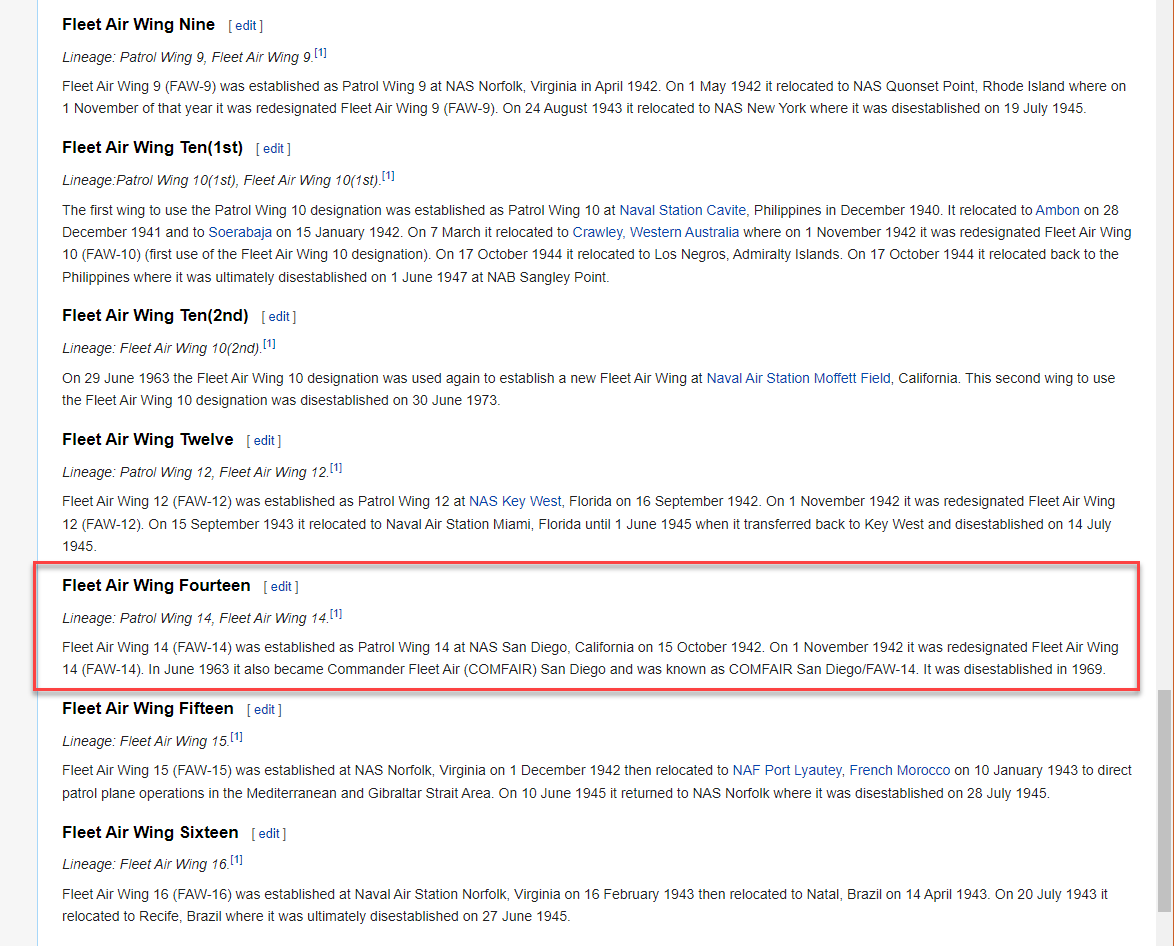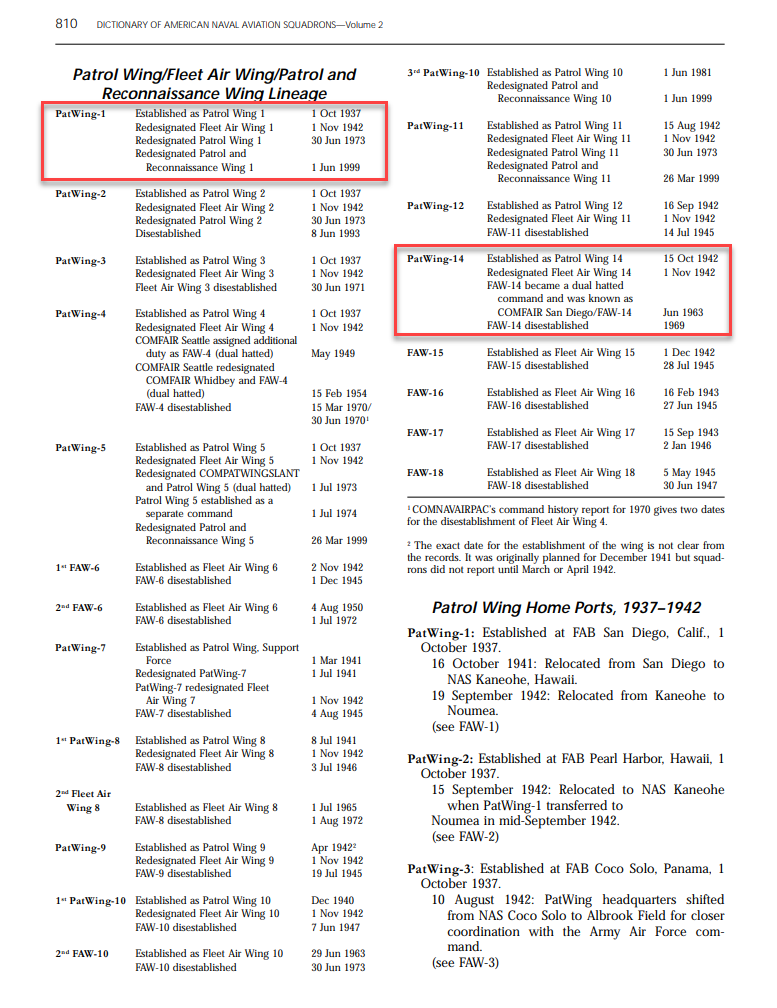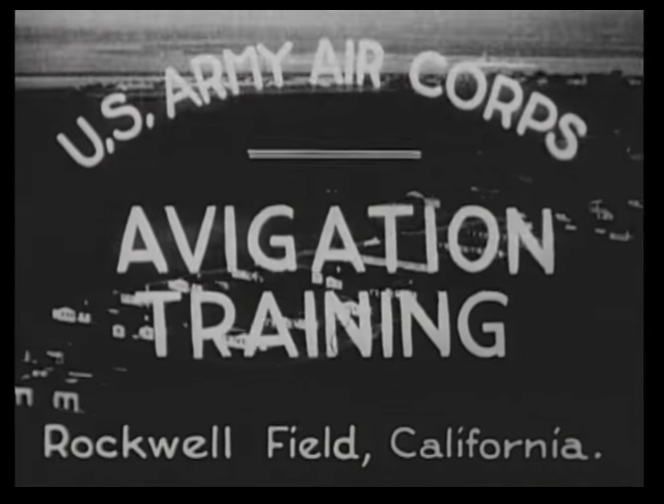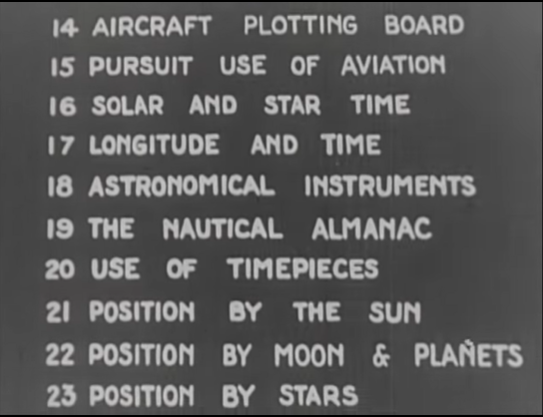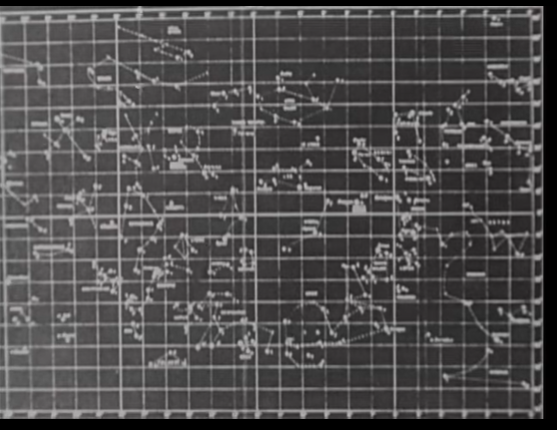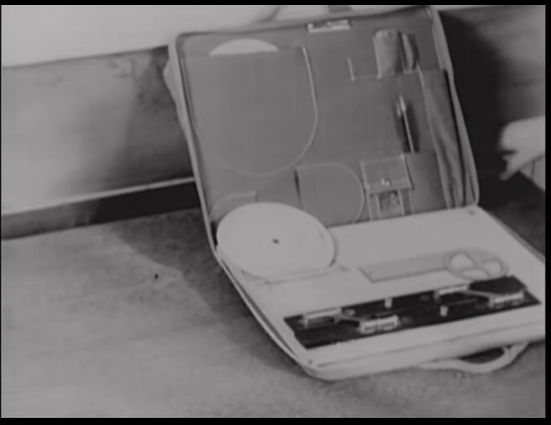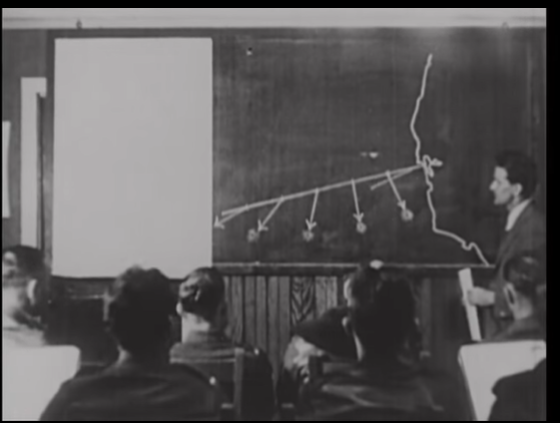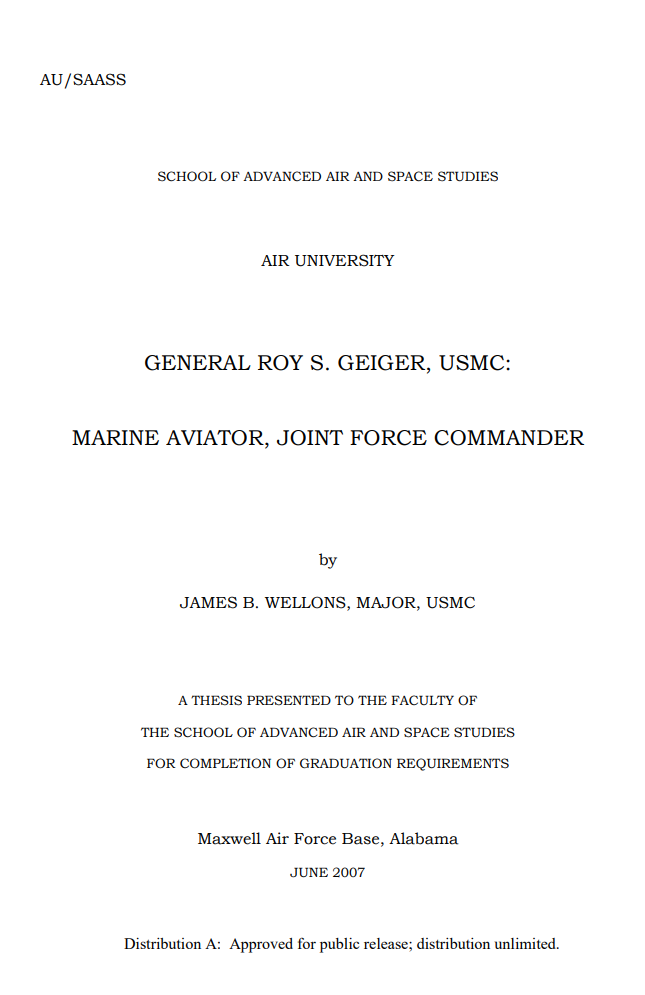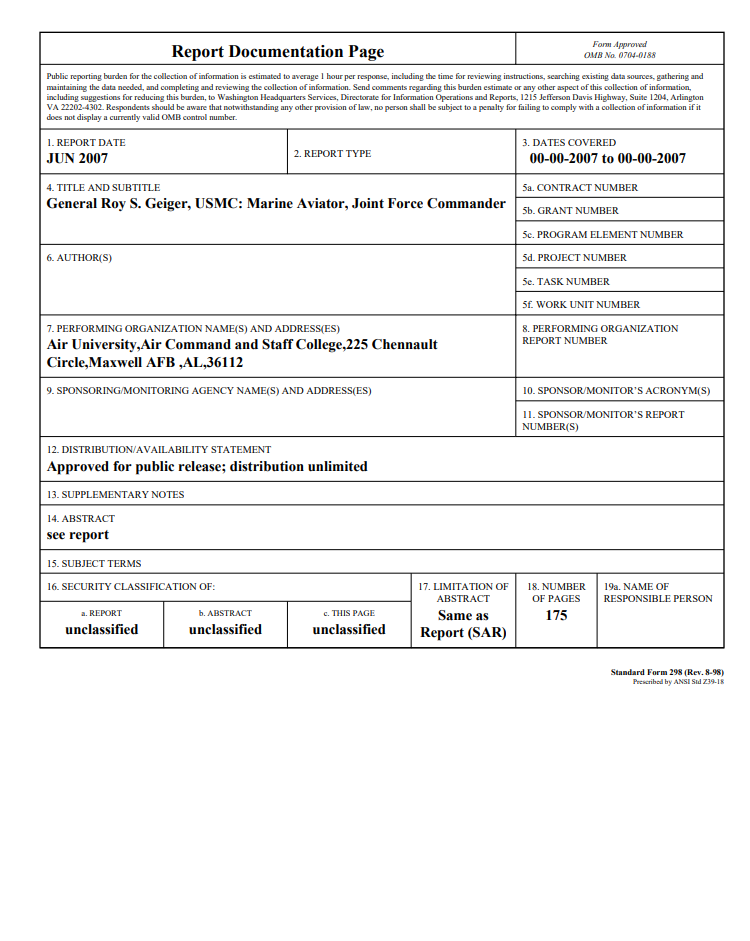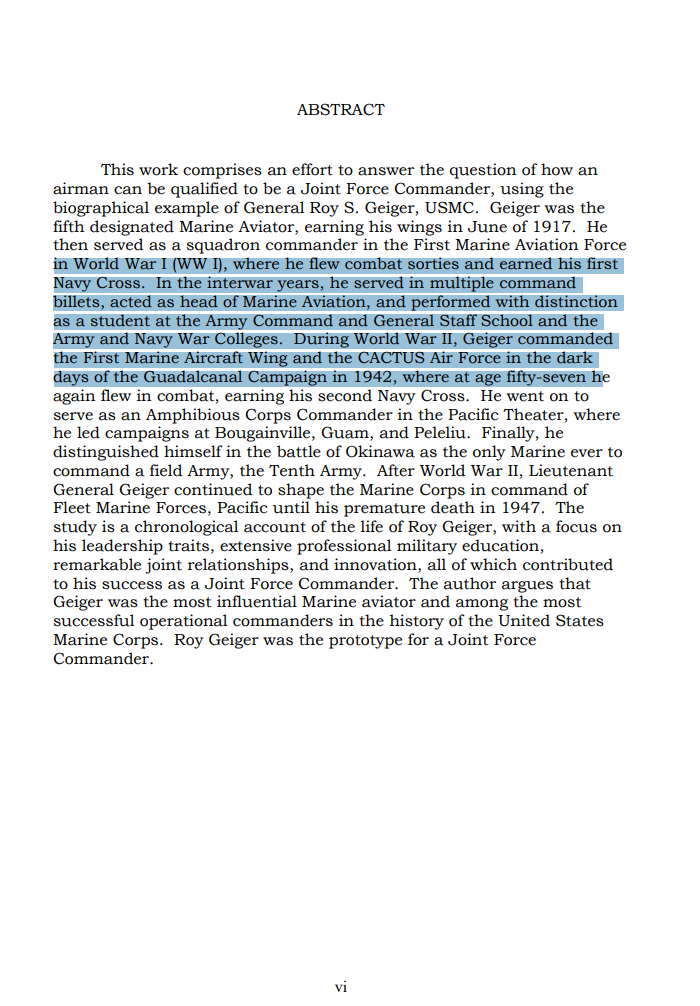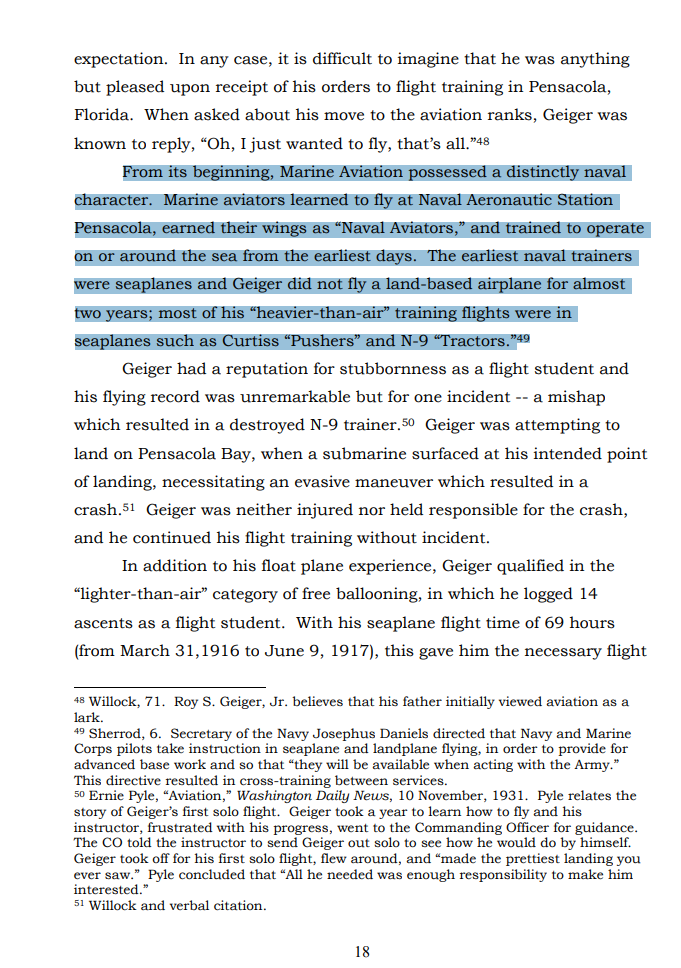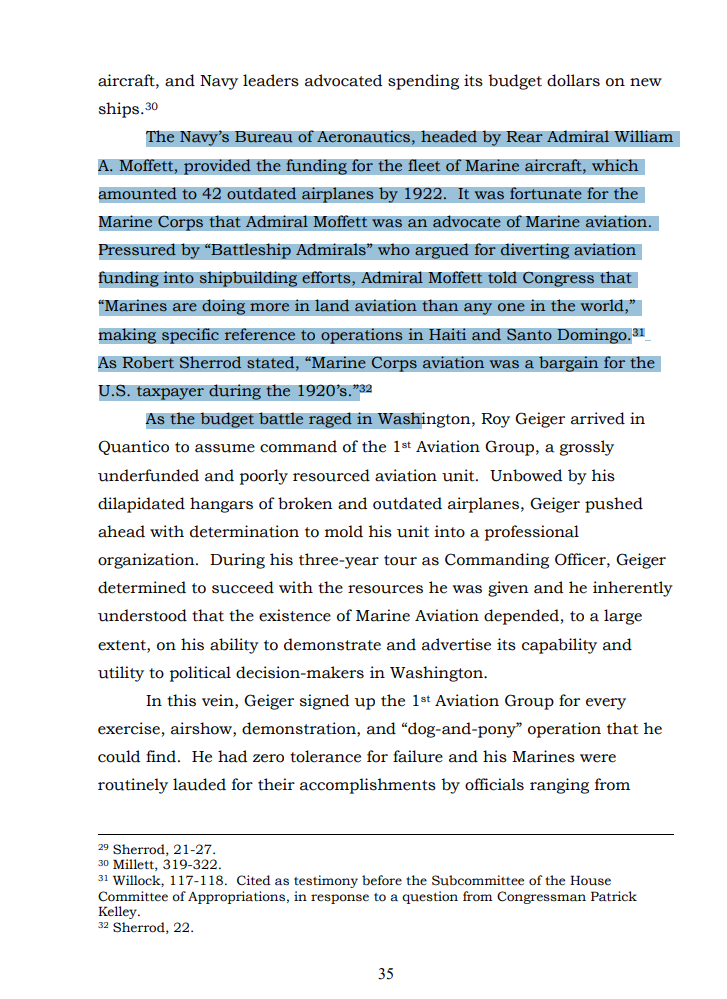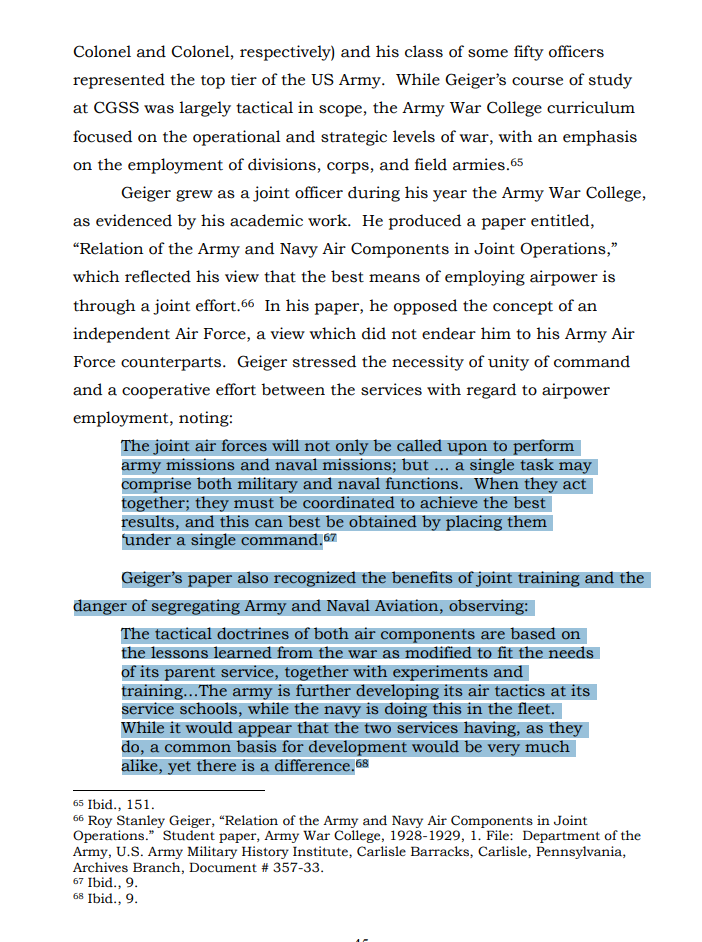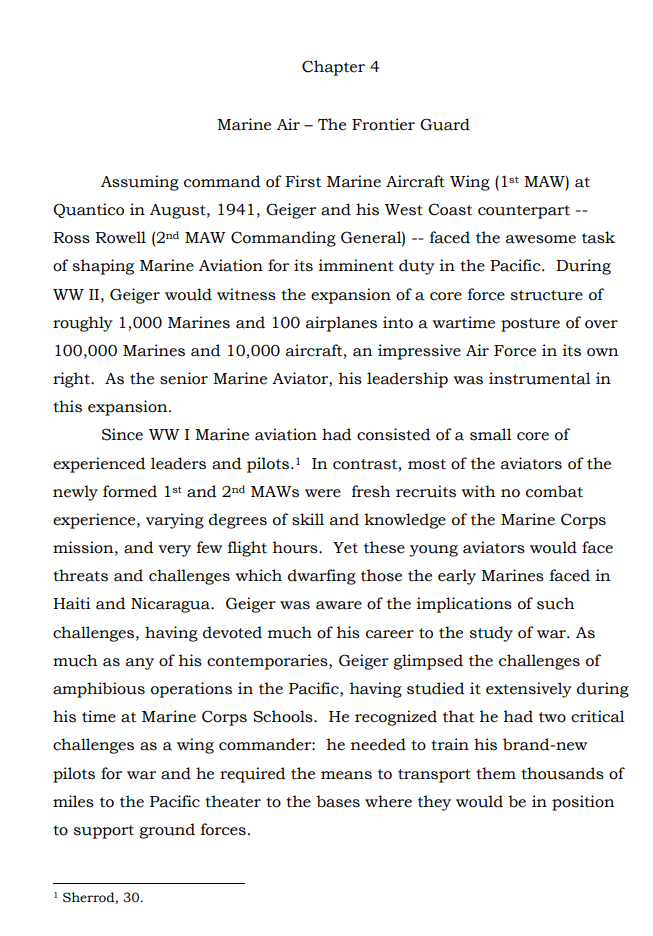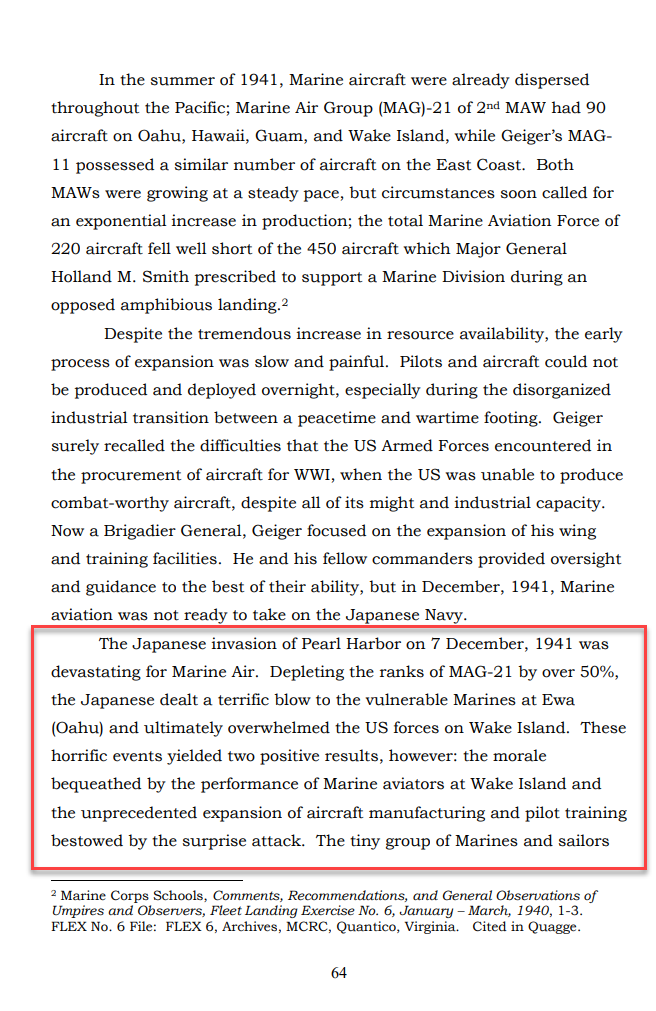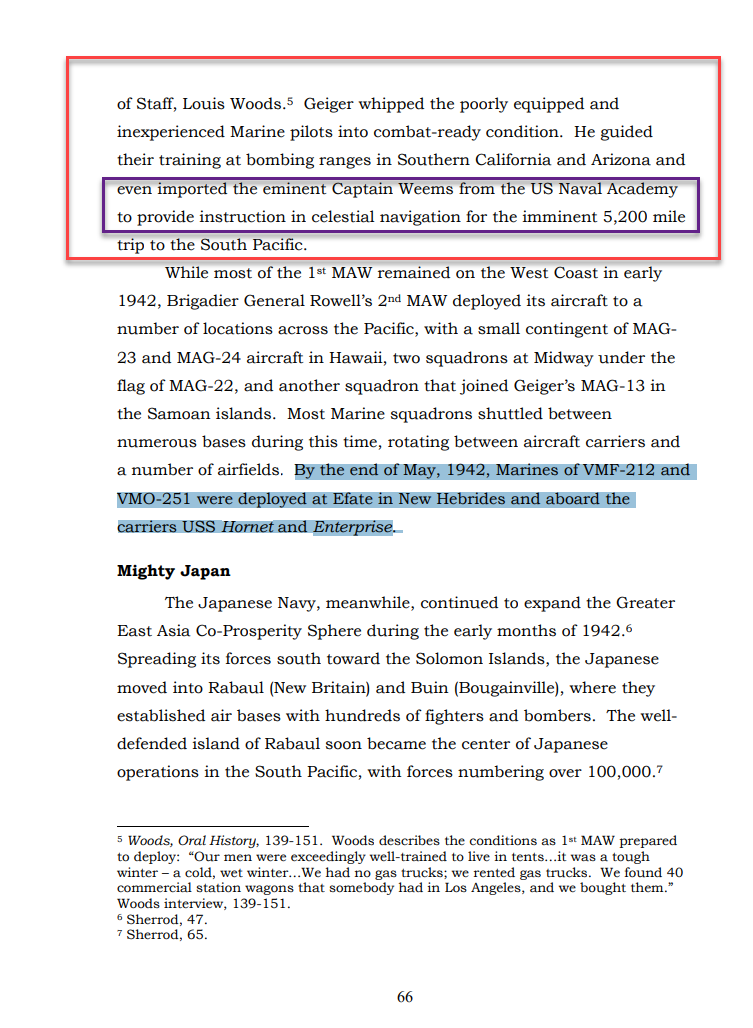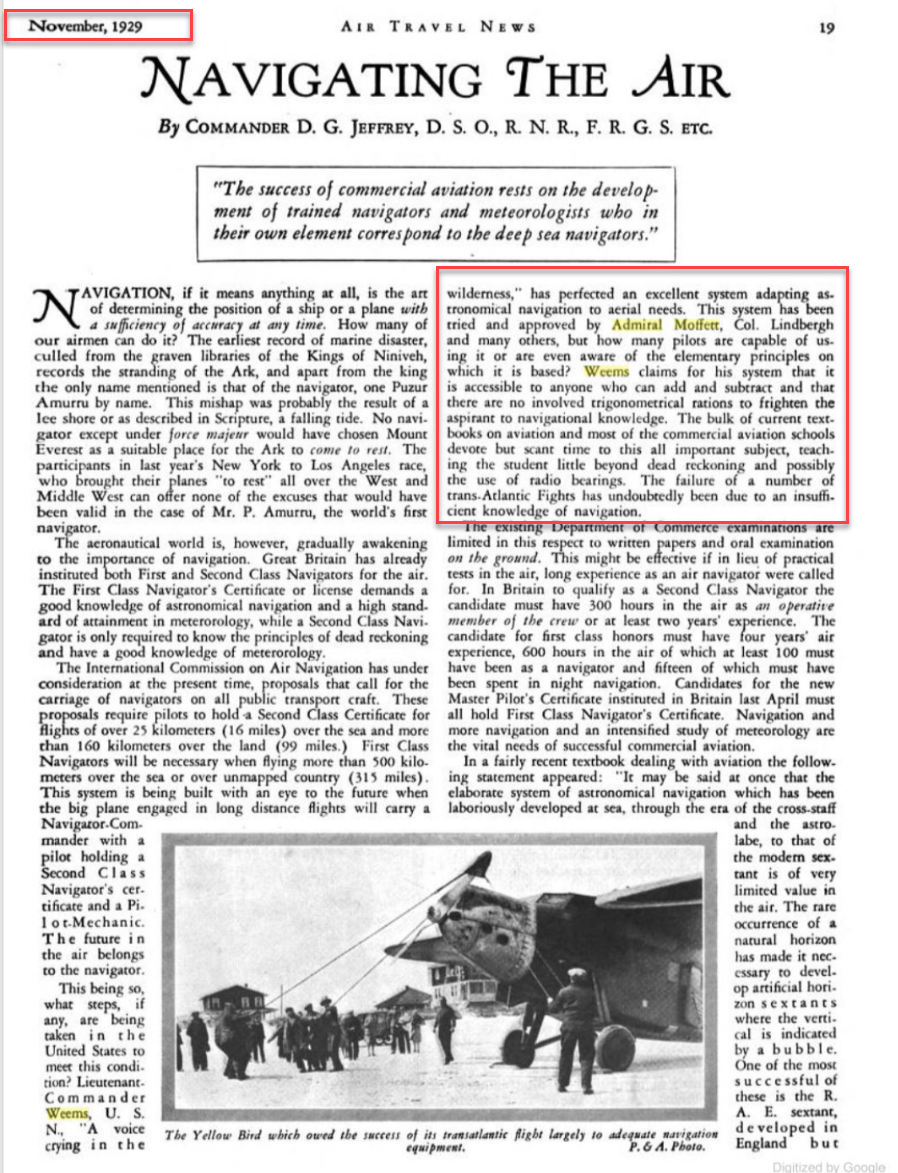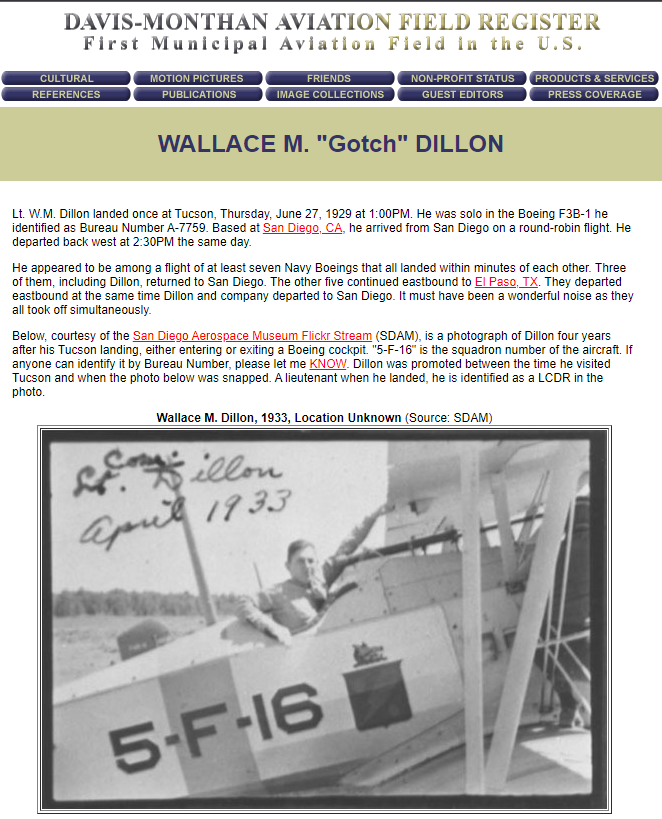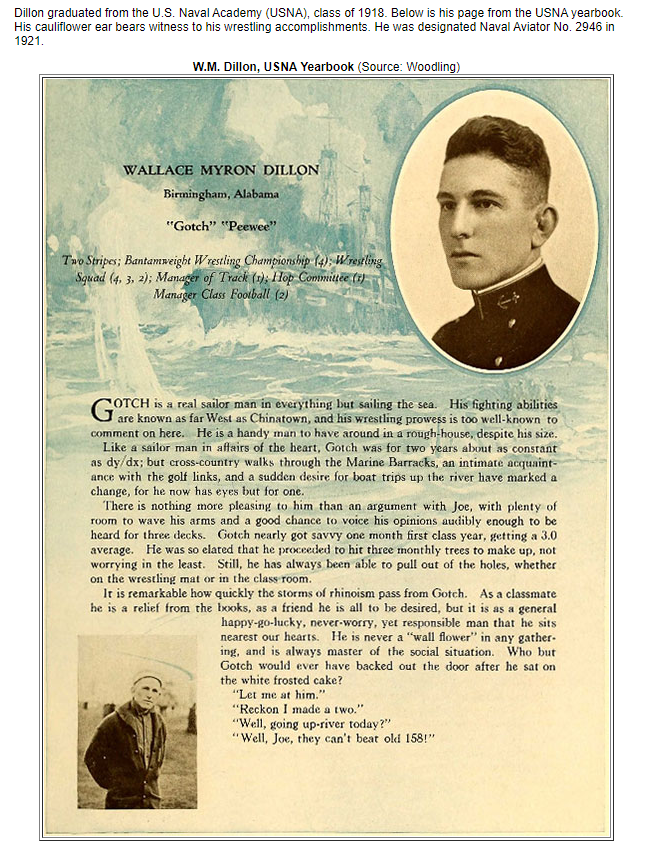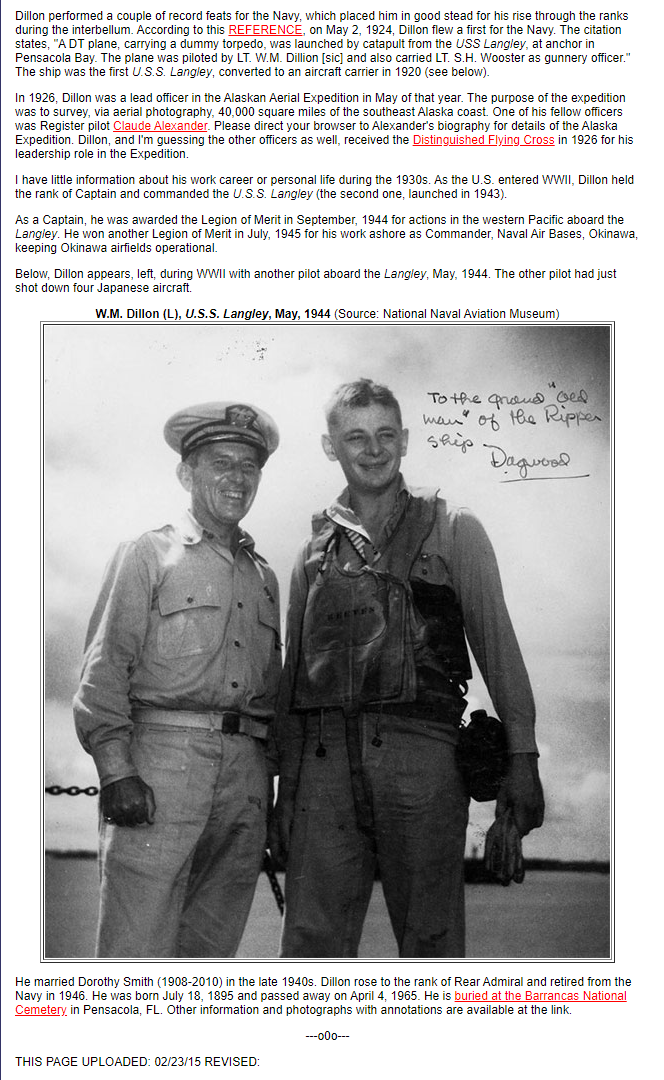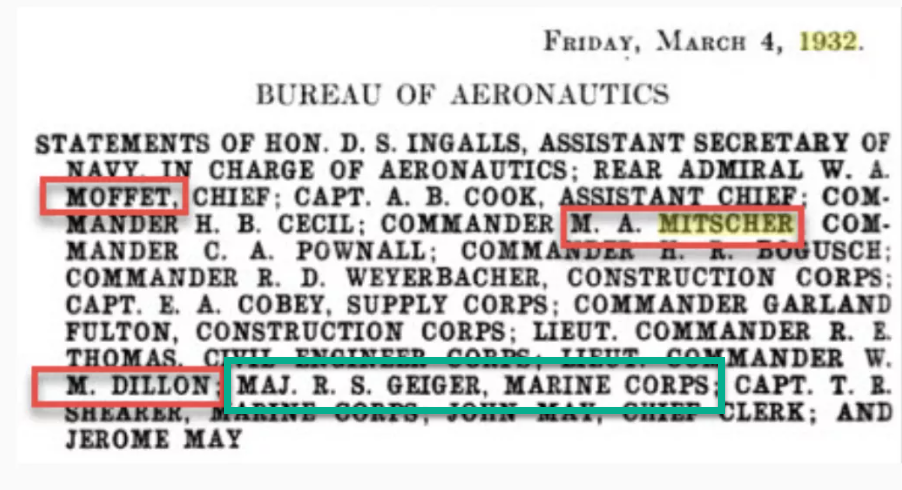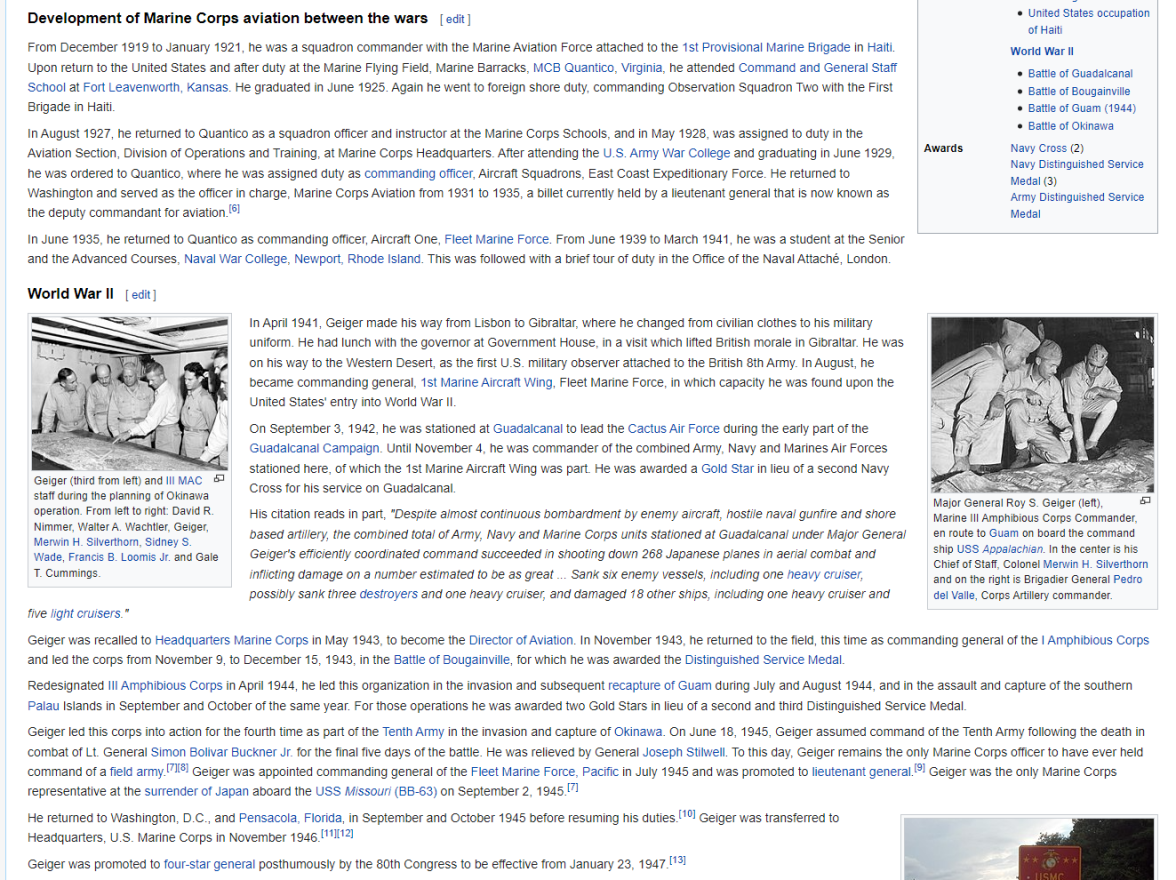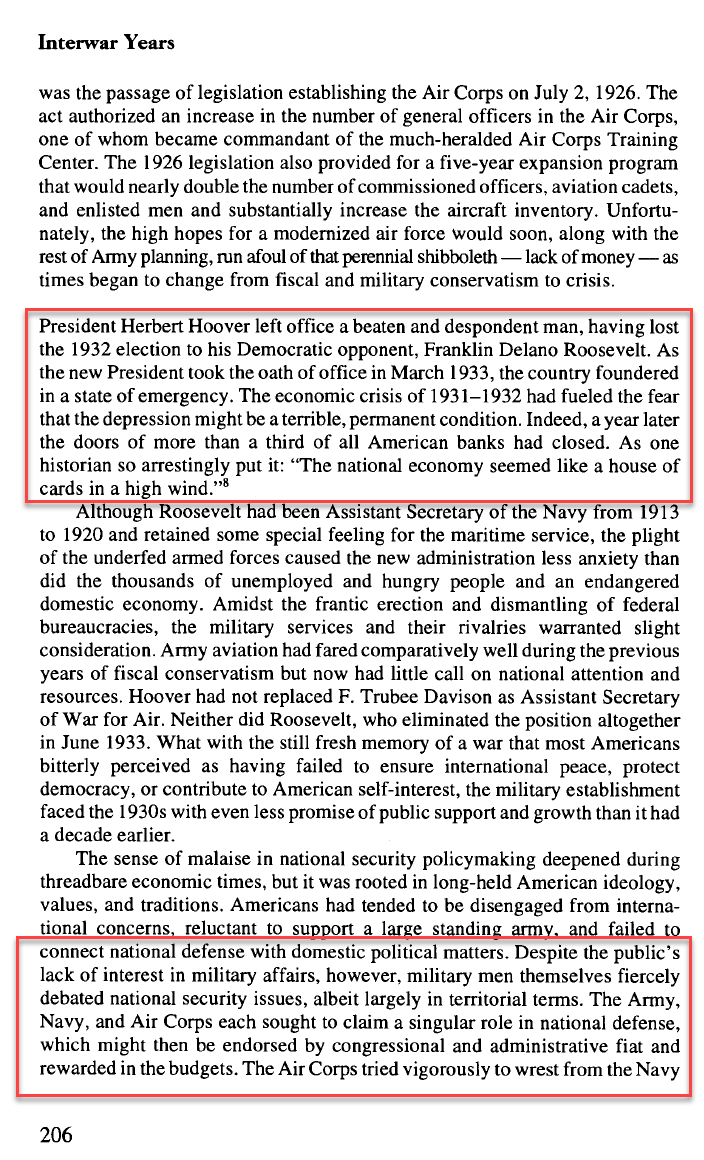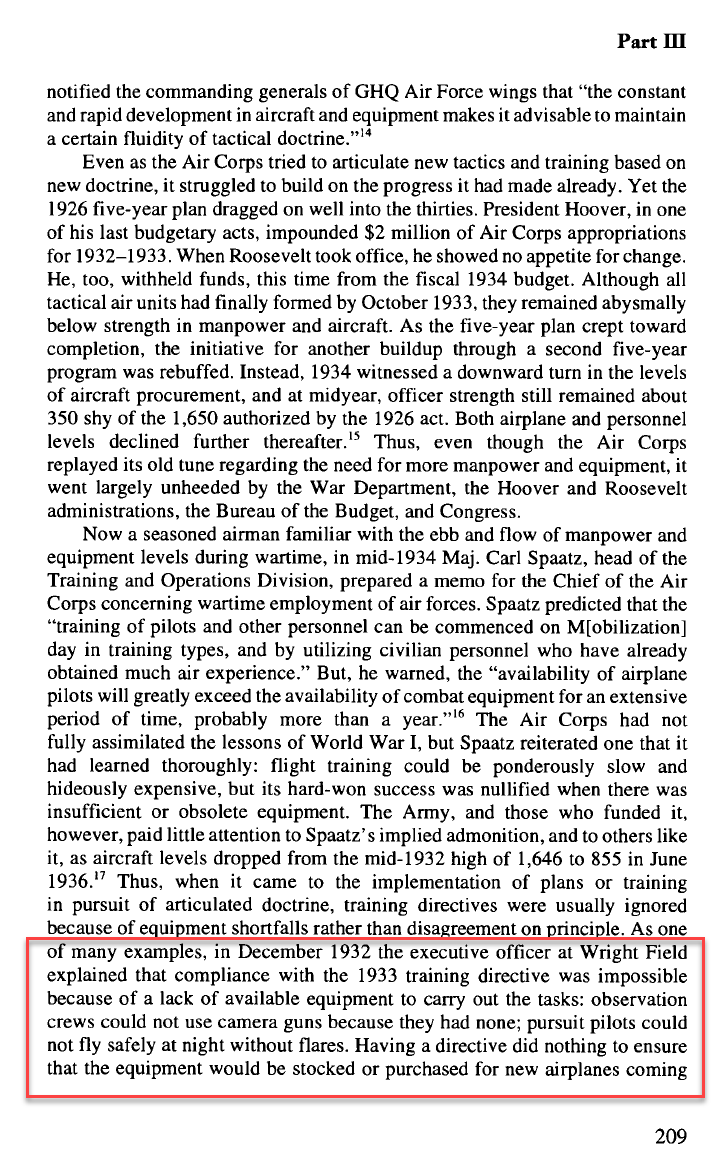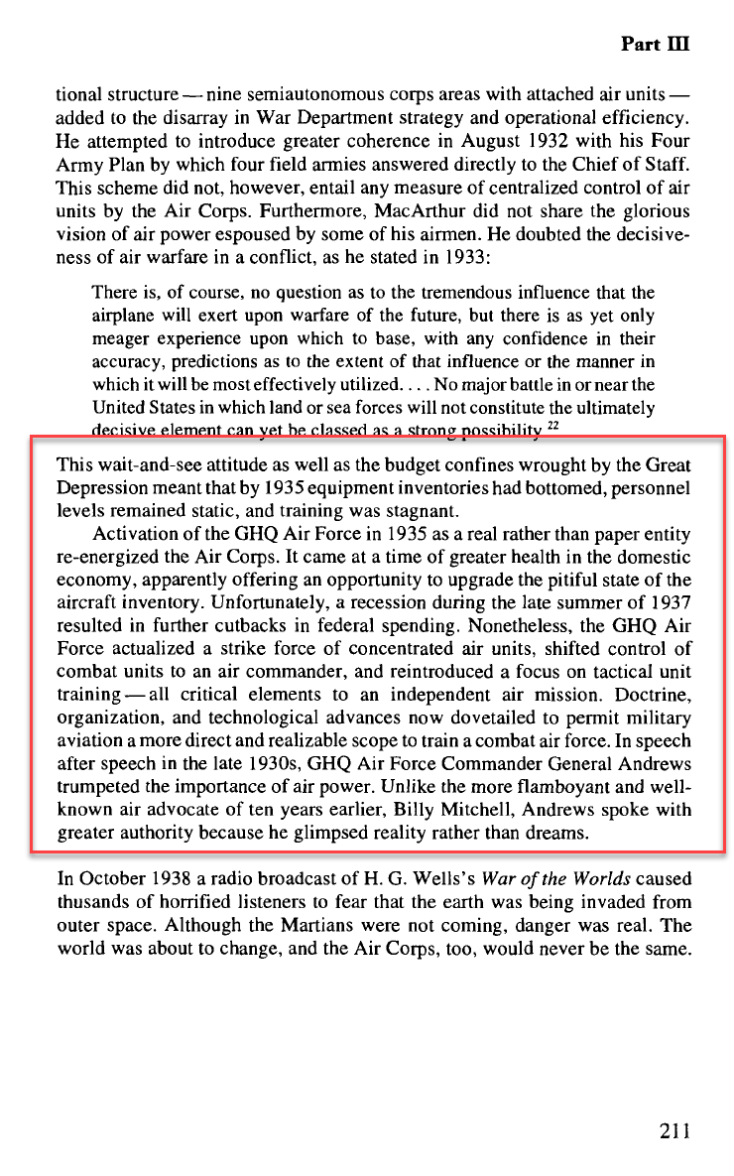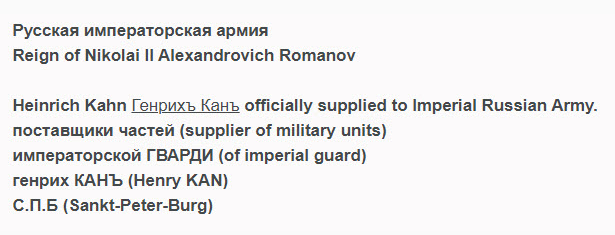Anyone have a historical watch?
Lépine
·Lépine
·What is interesting is that he is wearing a Navigational Watch. This is to me important since he is a pilot, it shows to me that it was very likely he wore any other Navigational Watch prior to getting the R88-W-800. And remember, he is still actively flying Navy planes while he is wearing the R88-W-800.


Omegafanman
·Good spot - They do not make crowns like they used to …..
Lépine
·I have tracked most all of the Annapolis Weems. All the ones I have details about are all 1937.
They were replaced with an order of 1200 A-11 Longines military spec Weems.

Unfortunately, I am sworn to secrecy and can not show you the actual document as it was shared with me in private by Zaf Basha.
So the Annapolis Weems was never a military order and the two alternatives was the Longines A-11 28mm watch that failed Pam Am trials in 1940 so AC-14164 was a one time order.

May 1, 1940 the Annapolis would have been a watch replaced many months later with the R88-W-800 and A-11
Spec 27834. This is why Mitscher is not seen wearing the Annapolis from 1940.


In 1937, Annapolis Weems may have already been obsolete.

They were replaced with an order of 1200 A-11 Longines military spec Weems.

Unfortunately, I am sworn to secrecy and can not show you the actual document as it was shared with me in private by Zaf Basha.
So the Annapolis Weems was never a military order and the two alternatives was the Longines A-11 28mm watch that failed Pam Am trials in 1940 so AC-14164 was a one time order.

May 1, 1940 the Annapolis would have been a watch replaced many months later with the R88-W-800 and A-11
Spec 27834. This is why Mitscher is not seen wearing the Annapolis from 1940.


In 1937, Annapolis Weems may have already been obsolete.

Edited:
Lépine
·Lépine
·ALEJANDRO BOVONE
·Thank you for taking the time to write a nice comment. Sometimes it's hard to tell if these posts are interesting without comments.
i agree. but the spirit of the forums is to encourage such interesting information and the person that takes the time to share it
cvalue13
·This is a great paper. If anyone wants a copy, let's figure out how to distribute it.
I believe this is it (PDF can be downloaded)
https://books.google.it/books/about...ton&hl=en&newbks=1&newbks_redir=1&redir_esc=y
Lépine
·Lépine
·This is one problem I was working on before taking a long break.
Mitscher is in charge of PatWing 1 around 1938-1941.
PatWing 1 was located in San Diego on North Island.
The document that show B-24 Liberators were part of FAW-14.
If I can find that, I have something to suggest he could have had bomber training.
Then Celestial Navigation Training is extremely likely occurred and there might be solid proof around the corner.
We know he flew with the PBY Catalinas that were at San Diego NAS.
PatWings were changed to Fleet Air Wings on 1941.
FAW-14 was also on San Diego North Island and it clearly had B-24s.
I am missing a document that shows that (logically) PatWing 1 that became FAW 1 on San Diego North Island also had B-24s.
Mitscher is in charge of PatWing 1 around 1938-1941.
PatWing 1 was located in San Diego on North Island.
The document that show B-24 Liberators were part of FAW-14.
If I can find that, I have something to suggest he could have had bomber training.
Then Celestial Navigation Training is extremely likely occurred and there might be solid proof around the corner.
We know he flew with the PBY Catalinas that were at San Diego NAS.
PatWings were changed to Fleet Air Wings on 1941.
FAW-14 was also on San Diego North Island and it clearly had B-24s.
I am missing a document that shows that (logically) PatWing 1 that became FAW 1 on San Diego North Island also had B-24s.
Edited:
Lépine
·So why would bomber training lead to Celestial Navigation?
This was filmed on North Island San Diego.
Celestial Navigation
Below is Weems wrist watches being used for Celestial Navigation 19:00 minutes into video.





Harold Gatty that was the head of the San Diego Weems Celestial Navigation School 34:00 minutes into video.
https://timeandnavigation.si.edu/multimedia-asset/us-army-air-corps-avigation-training


This was filmed on North Island San Diego.
Celestial Navigation
Below is Weems wrist watches being used for Celestial Navigation 19:00 minutes into video.





Harold Gatty that was the head of the San Diego Weems Celestial Navigation School 34:00 minutes into video.
https://timeandnavigation.si.edu/multimedia-asset/us-army-air-corps-avigation-training


Edited:
Waltesefalcon
·So why would bomber training lead to Celestial Navigation?
This was filmed on North Island San Diego.
Celestial Navigation
Below is Weems wrist watches being used for Celestial Navigation 19:00 minutes into video.





Harold Gatty that was the head of the San Diego Weems Celestial Navigation School 34:00 minutes into video.
https://timeandnavigation.si.edu/multimedia-asset/us-army-air-corps-avigation-training


Lépine
·I have been trying a different tact as of late. The USAAC was ironically the example by which all other military branches should have adopted Celestial Navigation developed by the USN. Finding clear documentation of how the Navy was adopting Celestial Navigation prior to 1940 is not so easy to find. How about the USMC? They had planes too as it turns out.
https://en.wikipedia.org/wiki/Roy_Geiger
It is interesting that the Marines went to the same Aviation schools as the Navy.
It is really interesting that the same Admiral pushing for Weems Navigation is the head of the Marines Aviation as well.
This is Geiger's thoughts on joint aviation tactics.
I don't see how Mitscher could not have known this was going on at the same Naval Air Station
with the fighter pilots on his carrier.
I guess I will have to find out if Geiger's Marines were on board April 1942 or if they were one board
after the Doolittle Raid. It's only a month difference.
Basically every pilot on board the USS Hornet by 1942 knows Celestial Navigation.
https://en.wikipedia.org/wiki/Roy_Geiger
It is interesting that the Marines went to the same Aviation schools as the Navy.
It is really interesting that the same Admiral pushing for Weems Navigation is the head of the Marines Aviation as well.
This is Geiger's thoughts on joint aviation tactics.
I don't see how Mitscher could not have known this was going on at the same Naval Air Station
with the fighter pilots on his carrier.
I guess I will have to find out if Geiger's Marines were on board April 1942 or if they were one board
after the Doolittle Raid. It's only a month difference.
Basically every pilot on board the USS Hornet by 1942 knows Celestial Navigation.
Edited:
Lépine
·Initially when I was reading the congressional report, I did not know that the celestial navigation training requirement was Weems Celestial Navigation. After reading many documents it became clear that it was indeed Weems CN.




Lt. M. Dillion is an important key to the confirmation that the two most knowledgeable witnesses appearing before congress knew what was Weems Celestial Navigation (well at least one of them without any doubts).

Over 40 hours of Weems Celestial Navigation was required for training in 1932.
Mitscher would therefore also need to have 40 hours of training.

So here he is, Lt. Dillion testifying about Weems Celestial Navigation before congress with Marc A Mitscher sitting next to him along with Admiral Moffett. Surely it would not be possible for Mitscher to not have ever heard of Weems and Celestial Navigation by this time.





Lt. M. Dillion is an important key to the confirmation that the two most knowledgeable witnesses appearing before congress knew what was Weems Celestial Navigation (well at least one of them without any doubts).

Over 40 hours of Weems Celestial Navigation was required for training in 1932.
Mitscher would therefore also need to have 40 hours of training.

So here he is, Lt. Dillion testifying about Weems Celestial Navigation before congress with Marc A Mitscher sitting next to him along with Admiral Moffett. Surely it would not be possible for Mitscher to not have ever heard of Weems and Celestial Navigation by this time.

Edited:
Lépine
·So at this point it seems very unlikely that Mitscher and Dillion were not involved in the procurement of this watch.
1931-1932 all of this is going on with getting funding for the Navy Pilots, fighting over budgets with the Army, appearing before Congress, requiring 40 hours of the Celestial Training etc.

By 1942, if Mitscher never took Celestial Navigation, he would have been the only pilot onboard the USS Hornet that had not taken the courses.
1931-1932 all of this is going on with getting funding for the Navy Pilots, fighting over budgets with the Army, appearing before Congress, requiring 40 hours of the Celestial Training etc.

By 1942, if Mitscher never took Celestial Navigation, he would have been the only pilot onboard the USS Hornet that had not taken the courses.
Lépine
·Lépine
·One question comes up, why would the military be interested in a smaller weems in 1937?
I don't have the facts. However, it comes at an interesting period in economic history.
Below is from the USAAC history.
In America, it's the Great Depression following the fall of the 1929 stock market and the Great Dust Bowl.
President Roosevelt is cutting military spending down to the bone.
This may also explain why the Annapolis Weems was such a great failure and why there is a quick disappearance of
the larger 47mm Weems. There aren't many made after 1937. Military could not purchase cameras and film. Also
the military found deck (pocket) watches a better alternative.
I don't have the facts. However, it comes at an interesting period in economic history.
Below is from the USAAC history.
In America, it's the Great Depression following the fall of the 1929 stock market and the Great Dust Bowl.
President Roosevelt is cutting military spending down to the bone.
This may also explain why the Annapolis Weems was such a great failure and why there is a quick disappearance of
the larger 47mm Weems. There aren't many made after 1937. Military could not purchase cameras and film. Also
the military found deck (pocket) watches a better alternative.
Lépine
·So this is not a historical watch, but is a bit interesting because of the time period and how the watch was commissioned.


Typically Imperial Russian watches were award watches and they looked like these.


Heinrick Kahn was also well known for award watches.



He was a scientific watch maker. A true master of the art and science.





If you can read Russian, this is a typical type of markings on his watches.


To Russian Watch collectors, Heinrich Kahn is considered a part of their history.
He was included in a museum exhibition of 200 watches spanning 240 years.

Because his watches are very rare. There is one in this museum.
https://www.spbmuseum.ru/funds/517/48269/?lang_ui=en
Very large museum apparently.



I think it is important to identify who Heinrich Kahn made the watches for.





This is the watch and a rare example of a wrist watch Heinrich Kahn. The dial was confirmed by Longines.




Typically Imperial Russian watches were award watches and they looked like these.


Heinrick Kahn was also well known for award watches.



He was a scientific watch maker. A true master of the art and science.





If you can read Russian, this is a typical type of markings on his watches.


To Russian Watch collectors, Heinrich Kahn is considered a part of their history.
He was included in a museum exhibition of 200 watches spanning 240 years.

Because his watches are very rare. There is one in this museum.
https://www.spbmuseum.ru/funds/517/48269/?lang_ui=en
Very large museum apparently.



I think it is important to identify who Heinrich Kahn made the watches for.





This is the watch and a rare example of a wrist watch Heinrich Kahn. The dial was confirmed by Longines.


Edited:
Lépine
·
The Horse Guards were the oldest cavalry regiment in the Imperial Russian Guards' Corps whose Colonel-in-Chief was the reigning Emperor, and they enjoyed all the rights and privileges conferred upon them by their high rank. Most of the monarchs who reigned in Russia were placed on the rolls of the Horse Guards as Heirs Apparent on the very day of their birth. The constant favour in which Russian Sovereigns held the Horse Guards is also shown by the fact that most of the Grand Dukes of Russia were placed on their rolls and that a large number of officers were selected from the Horse Guards to join His Majesty's Suite. It may indeed be said that, as regards the number of their officers appointed to serve in His Majesty's Suite, the Horse Guards ranked first among the regiments of the Imperial Guards. Following His Majesty and the Heir Apparent, other Members of the Imperial Family placed on the rolls of the Horse Guards at the time of the outbreak of the revolution were: Grand Duke Paul of Russia and iris son Grand Duke Dmitri of Russia, Grand Duke Constantine and his brother Grand Duke Dmitri of Russia, Grand Duke Nicholas of Russia and Prince John of Russia.
Any young gentleman wishing to become an officer in the Horse Guards had to submit, before obtaining his commission, to a rigourous secret ballot by the Officers' Corps. In most cases candidates were young gentlemen whose ancestors, fathers or near relations had held commissions in the Horse Guards in former years. It was this selection founded to a great extent on the hereditary principle, that was responsible for the ardent love officers of the Horse Guards have always felt for the regiment to which they were bound by so many family ties and traditions, for the rigourous and rigid discipline loyally observed by them on duty as in private life, for their high concept of honour and duly and for their boundless loyalty and fidelity toward their Sovereign. All officers of the Horse Guards were personally known to H. M. the Emperor.
The Horse Guards formed part of the garrison of St. Petersburg and their service was therefore very brilliant, but also very expensive. Officers hardly ever received their pay; as a rule it scarcely sufficed to cover certain necessary expenses of regimental life. In order therefore to be in a position to hold a commission in the Horse Guards an officer had to be in possession of ample private means. Most of the officers of the Horse Guards, whether married or single, lived in large flats placed at their disposal in the regimental barracks. An orderly chosen .from among the men of his squadron was attached to the person of every officer.
The Horse Guards were mounted on black horses. Each officer was obliged to keep at least two chargers. Within the last ten years before the outbreak of the war many officers' chargers had been imported from England, and it was the high class of their mounts that enabled the Horse Guards' officers' team to win three of the four great four miles steeple chases run at Krasnoie Selo in the presence of the Emperor and thus to secure His Majesty's prize.
The uniforms worn by officers of the Horse Guards were very numerous, a special uniform having to he worn at nearly every official function. The men's uniforms were also highly elaborate, although less so than the uniforms of the officers. A detailed description of all uniforms will be a feature of the third volume of the History of the Horse Guards which will also contain a large number of coloured plates representing the various uniforms worn by the Horse Guards under successive reigns.
The Officers' Mess of the Horse Guards was one of the largest and most beautiful in St. Petersburg and contained a very great number of various works of art, to say nothing of the priceless collections belonging to the Horse Guards' Museum, to which presents due to the generosity of Russian Monarchs and to that of officers of the Horse Guards were constantly being added. The vestry of the cathedral of the Annunciation, the regimental church of the Horse Guards, also contained a large number of works of art of inestimable historic value, nearly all of which were presents of Emperors and Empresses of Russia.
The quarters occupied by the Horse Guards in St. Petersburg covered a large area limited by the Horse Guards' Boulevard (1) on one side, and by Post Street (2), Annunciation Street (3) and Great Sea Street (4) on the other. The ground floor was occupied by the regimental stables, above them on the first floor were the barrack-rooms of the four squadrons and the auxiliary companies, and on the second floor the flats occupied by officers and a few civil officials in the regimental service. Regimental quarters also comprised the. Great and the Small Riding Schools. All military exercise whether on foot or on horse-back took place at the Great Riding School and it was there that every year on March 25th., Our Lady's Annunciation Day and Commemoration Day of the Horse Guards, a solemn Te Deum was sung, followed by a review on foot held by H. M. the Emperor. Again the Great Riding School was the scene of regimental " concours hippiques " for officers and men as well as of riding exercise in which all officers took part under the personal supervision of the Commander or the senior colonel. And, finally, it was at the Great Riding School that all inspections by commanding generals, hearing of complaints, horse parades, inspections of senior and junior contingents etc. took place, as did also the traditional review held by each new commanding officer on entering upon his duties. In one word, the Great Riding School was the very centre of regimental life and activity, with hardly an interval, from 6 a.m. to 6 p.m.
The Small Riding School was much less in size, it was used by officers only and its character was more intimate. Every day all lieutenants and sub-lieutenants look their riding exercise there; there also horses were trained for the "concours hippique". In the evening, during Lent, officers sometimes arranged carrousels and gymkhanas at the Small Riding School to which officers' families and guests were invited. These functions usually included supper at which music was provided by the regimental brass hand and balalaikas. The brass and balalaika bands of the Horse Guards were among the best of the Guards' Cavalry bands and their repertoire was very large. The instruments used by them were made of silver and were presents of former regimental aides-de-camp. The brass band of the Morse Guards reached the acme of its artistic development under the eonductorship of Mr. Anthony Ruzek who filled the post of chief conductor during 25 years.
Every week, on Thursday, gala dinners were given at the Officers' Mess of the Horse Guards at which the presence of all officers was compulsory. Absence could only be excused on account of illness or by special dispensation granted by the senior colonel. All officers were entitled !o invite their male friends to these dinners (ladies not being admitted), but such invitations had to be sanctioned by the senior colonel or a squadron commander. The regimental brass band played at dinner and the balalaika band after dinner. Sometimes, later in the evening, the chorus of regimental singers was called for. The chair was taken at dinner by the Commander or, in his absence, by the senior colonel. Officers were seated at table in accordance with their rank and seniority, the seat at the lower end of the table opposite the Commander being always occupied by the officer in charge of the Mess. An invitation to a Horse Guards' dinner was considered to be a great honour, and especially so in the case of civilians. After dinner some officers usually played at nine-pins in a large hall set apart for this and other sports, such as fencing, gymnastics and the like, while others played billiards on the two large tables in the billiard room, or cards in the Green Salon. Sometimes, if called for, a cold supper would be served at about midnight, the first course always being a traditional " onion soup ". This supper was familiarly called a " cold morsel ". Bat even if officers only left the Mess in the small hours, they were all obliged to be present at morning exercise with their squadrons ; any officer failing to do so was severely punished.
The Horse Guards occupied their quarters in St. Petersburg during the whole of the winter season, but on May 1th /14th. they moved to Krasnoie Selo for exercise in the field. There the four squadrons and all auxiliary companies were quartered in wooden barracks, owned by the Horse Guards and forming a small borough in the centre of which stood the regimental Church of St. Olga. This church was a true reproduction of the Cathedral of the Annunciation in St. Petersburg and had been built under Commander Major General the Prince Nakhitchevansky, of II. M. Suite. H. I. H. Grand Duke Dmitri of Russia, a former officer of the Horse Guards, had presented the Officers' Corps of His old regiment with the house He had lived in at Krasnoie Selo. This house was built in the style of a Russian " isba "' and had two storeys, and into it the Officers' Mess of the Horse Guards moved for the summer months every year. Officers used to live in the village of Krasnoie. Selo in small peasants' cottages which they rented for the summer.
The Horse Guards were one of the richest regiments in the Imperial Russian Guards, a large number of charity funds having been created for their benefit by former officers either at the time of their resignation or by will. Each of these funds had a special statute and income derived from them was used to make awards to or financially to assist men of the Horse Guards and their families. At the time the Horse Guards left their quarters in 1914 to take part in the war the sum total of such charity funds amounted to 325.000 roubles (about £ 34.500.-.-.).
Before bringing this short description of life in the Horse Guards in recent years to a close,, we feel we ought to mention in a few words certain characteristic facts of regimental life in years further removed from our time.
During the first century of the existence of the Horse Guards, all commissioned officers belonged to the Russian nobility and their families were intimately related to and associated with the Imperial Court. In the " Leib Regiment " even the men had ail been scions of noble families or of the best families of the landed gentry. It often happened that a private in the " Leib Regiment " owned hereditary lands and serfs. It also often happened that of two brothers one would be a commissioned officer and the other a private in the " Leib Regiment ". As a result of this exclusive selection of officers and men the " Leib Regiment " and later the Horse Guards naturally came to be considered as a school and a noviciate for future officers of all other Russian cavalry regiments. It was this exclusive selection too that accounted for the fact that the moral tone and the traditions of both these regiments have always borne the stamp of nobility and independence.
Lack of space unfortunately prevents us from entering into many interesting details which lent a particular character to life in the Horse Guards. It is however necessary to mention some facts of which they may be justly proud. We shall therefore recall that the powerful Field Marshal, His Serene Highness Prince Gregory Potemkin, counsellor and friend to Empress Catherine II, had been a sergeant in the Horse Guards. Field Marshal Count Alexis Rasoumovsky, who was morganatically married to Empress Elisabeth of Russia, was a Vice-Colonel-in-Chief of the Horse Guards. Field Marshal and Marshal of Artillery, Count (later Prince) Gregory Orloff, who played an important part in the palace revolution which enabled Empress Catherine II to ascend the Russian Throne and was ever since Her loyal counsellor and trusted adviser, was also a Vice-Colonel-in-Chief of the Horse Guards, as also was the famous Field Marshal Count. Roumiantzeif-Zadounaisky. Prince Alexis Orloff, President of the Council of the Empire, Aide-de-Camp General and friend to Emperor Nicholas I, had first been an officer in and later in command of the Horse Guards. Lastly, Count Wladimir de Freedericksz, Aide-de-Camp General to H.M. Emperor Nicholas II and Captain-in-Chief of the 4th. Squadron of the Horse Guards, began his military career as an officer in the Horse Guards, was later appointed to command that regiment and afterwards filled the post of Minister of the Imperial Household, and his advice always carried great weight with His Majesty Emperor Nicholas II.
All these eminent officers of the Horse Guards were, thanks to their exalted rank and position, the natural counsellors and trusted advisers to the Emperors and Empresses of Russia and, at the same time, formed a connecting link between the Horse Guards and their Imperial Colonels-in-Chief.
The seniority of the Horse Guards dated back to June 16th., 1706, the foundation day of His Serene Highness Prince Menshikov's Personal Squadron, which was later incorporated in the " Leib Regiment ", afterwards renamed Horse Guards.
The title of Colonel-in-Chief of the Horse Guards was always been borne by the reigning Emperor.
The following military honours have been conferred on the Horse Guards in recognition of feats of valour performed by them in the field: 1) a set of silver trumpets decorated with the riband of the order of St. George; 2) regimental colours decorated with the ribands of the orders of St. George and of St. Andrew, and 3) silver cavalry drums. The latter had been taken from the Swedes at the battle of Pcrevolotchnaia by H. S. H. Prince MenshikoiTs Personal Squadron and later came into the possession of the Horse Guards by right of inheritance.
In the course of an existence extending over more than two centuries the Horse Guards have taken an active part in almost all the wars waged by the Russian Empire. In order to spare the reader a long series of names of battles, we will content ourselves with indicating the campaigns in which a part was taken by the Horse Guards. These were the. campaigns of 1706, 1708, 1709, 1711, 17:57, 1738, 1739, 1742, 1788, 1789, 1805 (in the battle of Austerlitz they captured the colours of-the 4th. regiment of French Infantry of the Line which have since been conserved in the regimental Church in St. Petersburg), 1807, 1812, 1813, 1814 (in the battle of La Fere Champenoise the Horse Guards captured 6 French field-guns and later, on March 19th., entered into Paris, where quarters were assigned to them in the Military School), 1831, 1849, 1853-1853, 1904-1905 and lastly 1914-1917 (from the day of the mobilisation to that of the signature of the treaty of peace at Brest Litovsk ; at the battle of Kauschen, East Prussia, fought on August 6/19th., 1911, the Horse Guards captured two of the enemy's field-guns, four ammunition waggons and an elevated observation post.)
The Horse Guards may be considered as having been officially disbanded on December 19th., 1917, when a " committee " of men belonging to the two last squadrons which still preserved some traces of military organisation, decided to send home all the men and to deliver up their arms and other belongings to the newly formed troops o[ the Ukraina. Thus ended in ignominy and disgrace the more than two centuries long glorious existence of the Horse Guards, so full of gallant feats of arms and faithful service rendered to Emperor and Country.
Although the Horse Guards had thus ceased to exist, a number of former officers succeeded, during the civil war that followed the revolution, in forming a volunteer squadron of Horse Guards, which towards the end of the civil war had developed into a lour squadron cavalry regiment. During the whole of the terrible struggle against the bolsheviks and until the Russian Army was forced to leave Crimea, the Horse Guard's Squadron of Volunteers fought the enemy with the greatest courage and, by their valour and war-like virtues, established their right to he considered as heirs to the Horse Guards' name and fame. Following the Commander in Chief of the Russian Army in the South of Russia, General the Baroa de Wrangell, himself a former officer of the Horse Guards, the Squadron of Volunteers, after the end of the civil war, was first shipped to Constantinople there to form the Personal Escort of the Commander in Chief, and later removed to Servia where, for some time, it guarded that country's frontiers. Gradually however the Army of Volunteers was demobilised, the men of the Horse Guards' Squadron dispersed in various countries in search of a livelihood and the squadron ceased to exist.
Most of the former officers of the Horse Guards also soon left the East for the West in the hope of finding work. Some ten years ago they founded the Association of Former Officers of the Horse Guards and elected His Imperial Highness Grand Duke Dmitri of Russia to be their President of Honour. At the present time the Association of Former Officers of the Horse Guards has a membership of 97; the Association has been duly registered in France and its seat is in Paris.

Edited:
